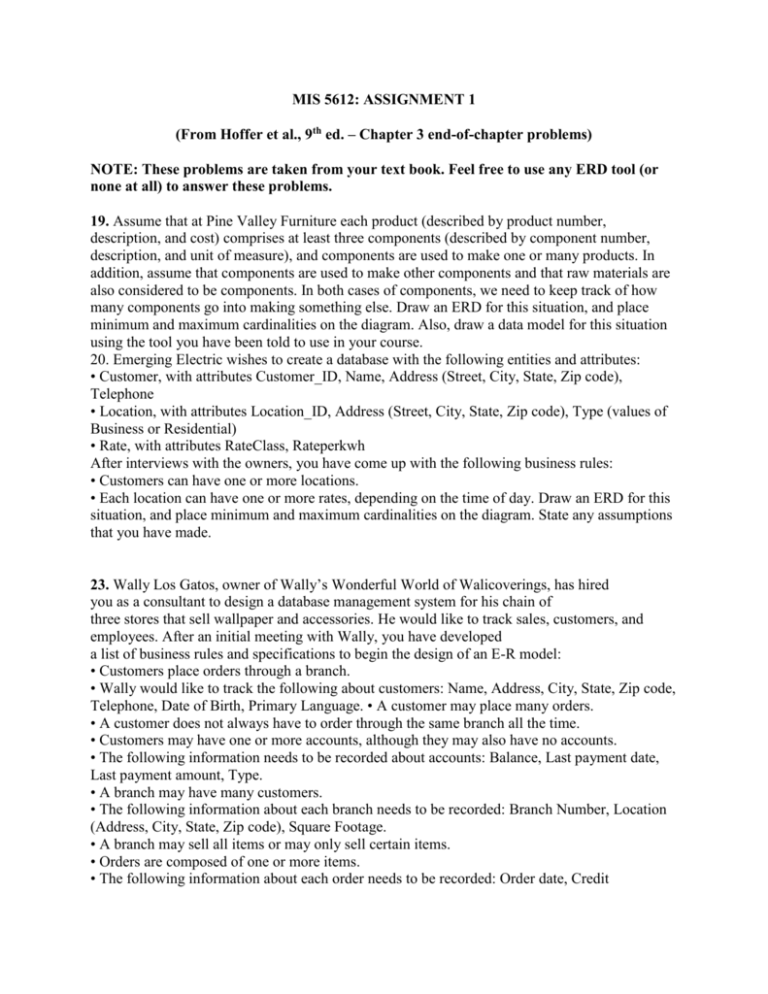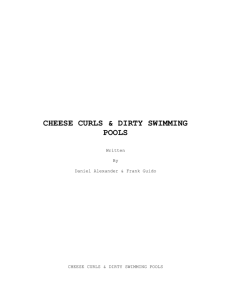MIS 5612: ASSIGNMENT 1 (From Hoffer et al., 9th ed. – Chapter 3
advertisement

MIS 5612: ASSIGNMENT 1 (From Hoffer et al., 9th ed. – Chapter 3 end-of-chapter problems) NOTE: These problems are taken from your text book. Feel free to use any ERD tool (or none at all) to answer these problems. 19. Assume that at Pine Valley Furniture each product (described by product number, description, and cost) comprises at least three components (described by component number, description, and unit of measure), and components are used to make one or many products. In addition, assume that components are used to make other components and that raw materials are also considered to be components. In both cases of components, we need to keep track of how many components go into making something else. Draw an ERD for this situation, and place minimum and maximum cardinalities on the diagram. Also, draw a data model for this situation using the tool you have been told to use in your course. 20. Emerging Electric wishes to create a database with the following entities and attributes: • Customer, with attributes Customer_ID, Name, Address (Street, City, State, Zip code), Telephone • Location, with attributes Location_ID, Address (Street, City, State, Zip code), Type (values of Business or Residential) • Rate, with attributes RateClass, Rateperkwh After interviews with the owners, you have come up with the following business rules: • Customers can have one or more locations. • Each location can have one or more rates, depending on the time of day. Draw an ERD for this situation, and place minimum and maximum cardinalities on the diagram. State any assumptions that you have made. 23. Wally Los Gatos, owner of Wally’s Wonderful World of Walicoverings, has hired you as a consultant to design a database management system for his chain of three stores that sell wallpaper and accessories. He would like to track sales, customers, and employees. After an initial meeting with Wally, you have developed a list of business rules and specifications to begin the design of an E-R model: • Customers place orders through a branch. • Wally would like to track the following about customers: Name, Address, City, State, Zip code, Telephone, Date of Birth, Primary Language. • A customer may place many orders. • A customer does not always have to order through the same branch all the time. • Customers may have one or more accounts, although they may also have no accounts. • The following information needs to be recorded about accounts: Balance, Last payment date, Last payment amount, Type. • A branch may have many customers. • The following information about each branch needs to be recorded: Branch Number, Location (Address, City, State, Zip code), Square Footage. • A branch may sell all items or may only sell certain items. • Orders are composed of one or more items. • The following information about each order needs to be recorded: Order date, Credit authorization status. • Items may be sold by one or more branches. • We wish to record the following about each item: Description, Color, Size, Pattern, Type. • An item can be composed of multiple items; for example, a dining room wall- covering set (item 20) may consist of wallpaper (item 22) and borders (item 23). • Wally employs 56 employees. • He would like to track the following information about employees: Name, Address (Street, City, State, Zip code), Telephone, Date of Hire, Title, Salary, Skill, Age. • Each employee works in one and only one branch. • Each employee may have one or more dependents. We wish to record the name of the dependent as well as the age and relationship. • Employees can have one or more skills. Based upon this information, draw an E-R model. Please indicate any assumptions that you have made. 24. Our friend Wally Los Gatos (see Problem and Exercise 23), realizing that his wallcovering business had a few wrinkles in it, decided to pursue a law degree at night. After graduating, he has teamed up with Lyla El Pàjaro to form Peck and Paw, Attorneys at Law. Wally and Lyla have hired you to design a database system based upon the following set of business rules. It is in your best interest to perform a thorough analysis, to avoid needless litigation. Please create an ERD based upon the following set of rules: • An ATTORNEY is retained by one or more CLIENTs for each CASE. • Attributes of ATTORNEY are: Attorney_ID, Name, Address, City, State, Zip_Code, Specialty (may be more than one), Bar (may be more than one). • A CLIENT may have more than one ATTORNEY for each CASE. • Attributes of CLIENT are Client_ID, Name, Address, City, State, Zip_Code, Telephone, Date_of_Birth. • A CLIENT may have more than one CASE. • Attributes of CASE are Case_ID, Case_Description, Case_Type. • An ATTORNEY may have more than one CASE. • Each CASE is assigned to one and only one COURT. • Attributes of COURT are Court_ID, Court_Name, City, State, Zip_Code. • Each COURT has one or more JUDGEs assigned to it. • Attributes of JUDGE are Judge_ID, Name, Years_in_Practice. • Each JUDGE is assigned to exactly one court. Please state any assumptions that you have made.

